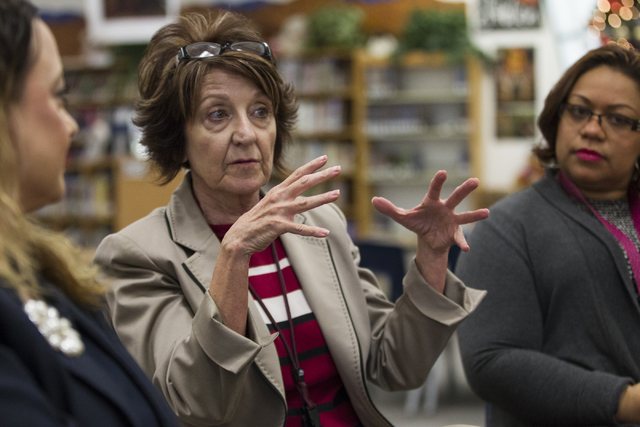CCSD overhaul lumbers ahead amid confusion, mistrust
Leilani Hoe, proud mom of two students at Monaco Middle School, is always in the building.
She’s attended some of Monaco’s parenting classes. She was on the Parent-Teacher Association board. She fought against the possibility of a charter conversion when the school was listed as underperforming and eligible for the Achievement School District.
Now, she’s one of the parents elected to Monaco’s School Organizational Team, a group of teachers, support staff and parents that will oversee each school as part of the massive district-wide reorganization.
“I came here to be a part of something,” Hoe said. “I want to see my kids be something later on in life.”
The reorganization law known as AB 394 presents a huge undertaking for the Clark County School District. Under a new system, principals and school teams will be given more power over their building. They’ll craft their own school budget and decide which services they want.
In essence, it’s a breakdown of an oversized kingdom into smaller nation-states with the goal of improving student performance.
But work done at the local level to prepare for the new model by 2017-18 has not been in lockstep with Clark County School Board trustees’ concerns, which are bogged down with paperwork and confusion.
The disarray that remains less than one year before the rollout presents one pressing question: Can something this extensive really work and be finished in time?
THE PROBLEMS
The clock was reaching midnight Thursday as Glenn Christenson, chair of the Community Implementation Council, which is tasked with overseeing the reorganization transition, made a desperate plea.
“We really need to work better together,” he said to the school board.
The analysis that a hired consultant, the TSC2 Group, had been trying to do wasn’t as thorough as he would’ve liked.
That’s because the hiring of TSC2 irked trustees, who must foot a bill of up to $1.2 million that the legislative advisory committee for AB 394 approved seemingly without warning. The move only further strained relations between state legislators and the district.
Trustees have been accused of obstructing the process, though they continuously insist they just want to address questions and concerns.
And those concerns are many. In November, the board sent a 12-page petition to state Board of Education outlining issues with the law’s regulations.
There’s confusion over the board’s authority, concern over the accelerated timeline for a 2017-2018 rollout, and an urgent need for a weighted student funding formula to help determine how much money schools should budget for their kids.
Among school organizational team membership, there’s further confusion as to how to elect support staff and teacher members if not enough of them are part of their respective unions.
Regulations state that two of the four teacher and support-staff team members must be part of the two unions.
“What I’m hearing is that people are feeling disenfranchised, that they cannot participate because of their union or lack of union membership,” District F Trustee Carolyn Edwards said at a board retreat earlier this month.
When the Clark County Education Association explained that it had issued waivers for teachers who won elections but might not be part of the union, all frustration broke loose.
How do the law’s regulations address those exceptions? Who approves those teams if they’re not formed with the union-membership ratio outlined in the regulations?
“My concern is that there seems to be a belief that you can pick and choose when you want to use the regulations and when you don’t,” District B Trustee Chris Garvey said at the most recent board meeting.
The petition asks the state Board of Education to reopen the regulations for discussion.
NONSTOP WORK
Yet while confusion bubbles at the higher level, district staff have still hit the ground running since the law’s regulations were passed in September.
They launched a website on the process for the public, hired 16 associate superintendents required to oversee up to 25 schools each and trained principals on their increased duties.
“I agree there’s a lot of work to be done,” said Deputy Superintendent Kim Wooden. “This is a critical time because this is where you set the foundation that we can build upon and help our schools and community really come together.”
Meanwhile, there’s the whopping task of finances. The law requires 80 percent of the district’s budget to be dedicated to school services in the first year, with the remaining 20 percent left for central offices. That percentage will move up to 85 in the years to follow.
That means staff are combing through the budget line by line to determine which services are school-based and which come from central offices.
The new budgeting method could also leave a concern for support staff paid through the central office budget: Will 15 percent left for central services be enough to pay for those jobs?
The district doesn’t anticipate any layoffs with the 80-20 split the first year, but it’s the future that is uncertain.
Wooden said it’s too early to tell if there could be any layoffs beyond that first year, as the district still needs to determine which services may be controlled by schools.
“In the regulations, (the schools) are to help us determine which central services might be transferred,” she said.
Guillermo Vazquez, executive director of the Education Support Employees Association, which represents support staff, said the main concern is over what the reorganization really means for jobs.
“There is some fear, concerns, but our leaders are getting it,” he said.
MONEY
Perhaps the biggest obstacle facing the district is the weighted funding formula.
That formula would assign more money to students in one of four categories: gifted and talented, free and reduced lunch recipients, English language learners and special education.
There has been even more confusion between the state and the district over who should establish those weights. The state superintendent of public instruction has most recently told the district that it can establish those amounts for next school year.
Either way, the district needs a firm plan in place by January, when school organizational teams begin to develop individual budgets in accordance with the type of students they have enrolled.
Beyond next year, the district is hoping the Legislature will provide the extra money required for those students.
Yet despite all the troubles and hurdles left to jump, an air of hope remains at schools like Monaco and for mothers like Hoe.
“We’ll work it good,” she said of the commitment that lies ahead. “Believe me. We’ll figure it out one way or another.”
Contact Amelia Pak-Harvey at 702-383-4630 or apak-harvey@reviewjournal.com. Follow @AmeliaPakHarvey on Twitter.
RELATED
Reorganization of Clark County School District gets final approval
Angry trustees agree to stay on council overseeing CCSD reorganization
Clark County School District to pay $1.2M for reorganization work






























